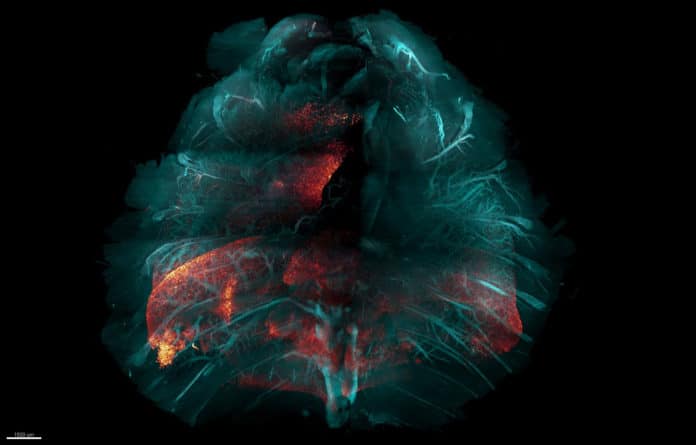Introducing HYBRiD, a new tissue-clearing method developed by scientists at Scripps Research. It makes large biological samples transparent, making it easier for scientists to visualize and study healthy and disease-related biological processes occurring across multiple organ systems.
Understanding physiology and disease across multiple organ systems has long been a challenge in biology. Advancements ins tissue-clearing techniques allowed scientists to characterize mammalian tissues in 3D. However, it remains challenging to imagine the mammalian body en bloc.
With HYBRiD, scientists achieved high transparency, protein retention, and compatibility with direct fluorescent imaging and immunostaining in cleared mammalian bodies.
HYBRiD stands for Hydrogel-Based Reinforcement of Three-Dimensional Imaging Solvent-Cleared Organs (DISCO). Scientists developed this by combining elements of the two main prior approaches to tissue-clearing technology.
In the Tissue-clearing process, solvents are used to remove molecules that make tissue opaque. This renders the tissue optically transparent while keeping most proteins and structures in place. Scientists commonly use genetically encoded or antibody-linked fluorescent beacons to mark active genes or other molecules of interest in a lab animal. In principle, tissue clearing allows these beacons to be imaged all at once across the entire genome animal.
Previous methods work well for brains, but they don’t work so well when applied to other body parts or whole bodies. These methods- that use either organic or water-based solvents- tend to diminish fluorescent signals and are impractically weak for clearing non-brain tissue. Both methods require burdensome, labor-intensive procedures, often using hazardous chemicals.
Yu Wang, a graduate student in the Ye laboratory who was the paper’s co-first author, said, “An ordinary lab generally can’t use these methods routinely and at scale.”
Scientists created HYBRiD using a sequential combination of organic solvents and water-based detergents. They also used water-based hydrogels to protect those molecules within the tissue that need to be preserved. It often does not require the pumping of solvents through the sample.
Co-first author Victoria Nudell, a research assistant in the Ye lab, said, “In many cases, you can just put the whole thing in a jar and keep it in a shaker on your benchtop until it’s done. This makes it practical and scalable enough for routine use.”
Scientists tested this method in a variety of applications. These included a collaboration with the laboratory of John Teijaro, Ph.D., associate professor of immunology and microbiology, to image SARS-CoV-2-infected cells in the whole chests of mice for the first time—a procedure whose simplicity, with the new method, enabled it to be done in a high-level biosafety facility where access to equipment is strictly limited.
Journal Reference:
- Nudell, V., Wang, Y., Pang, Z. et al. HYBRiD: hydrogel-reinforced DISCO for clearing mammalian bodies. Nat Methods (2022). DOI: 10.1038/s41592-022-01427-0
